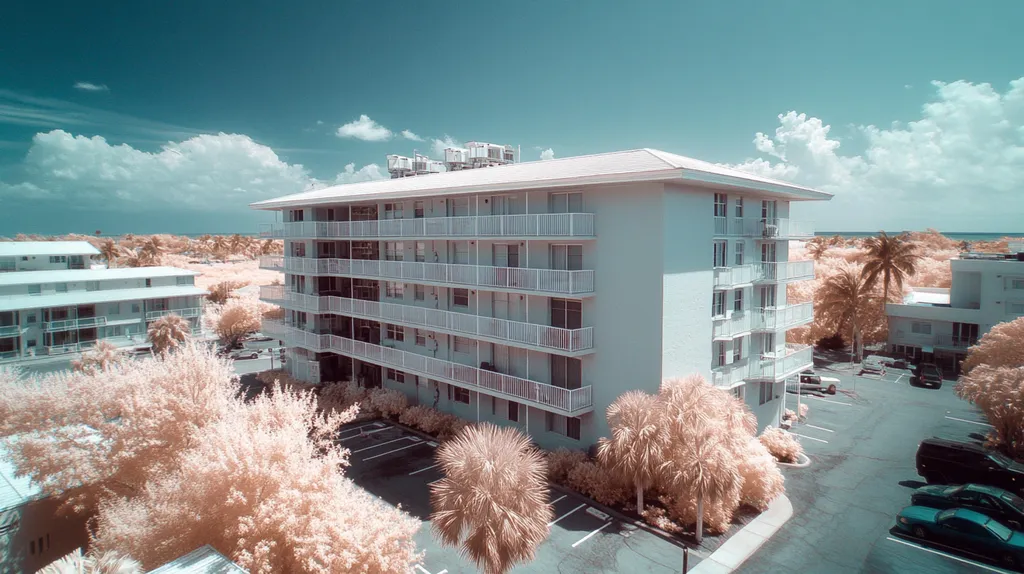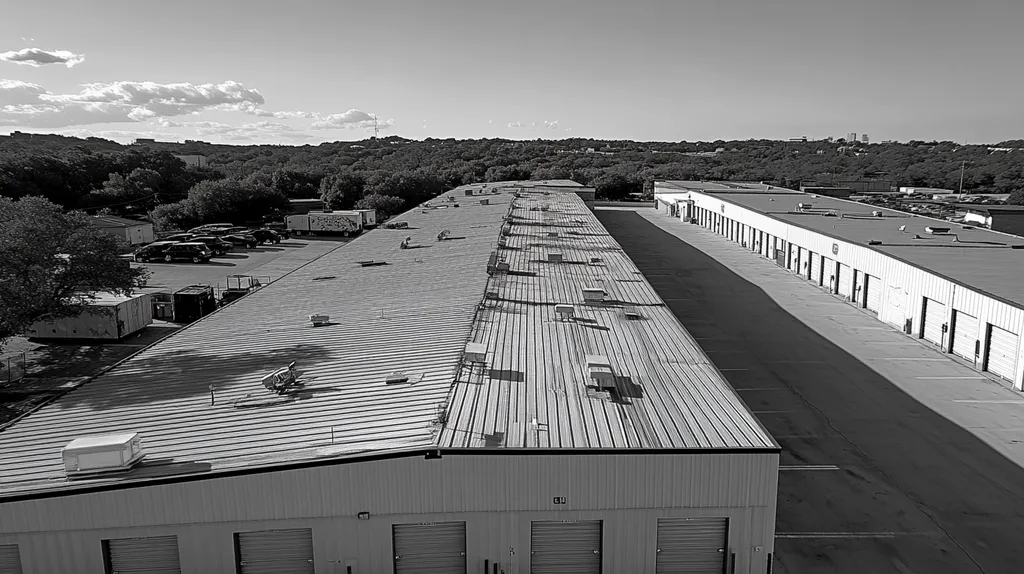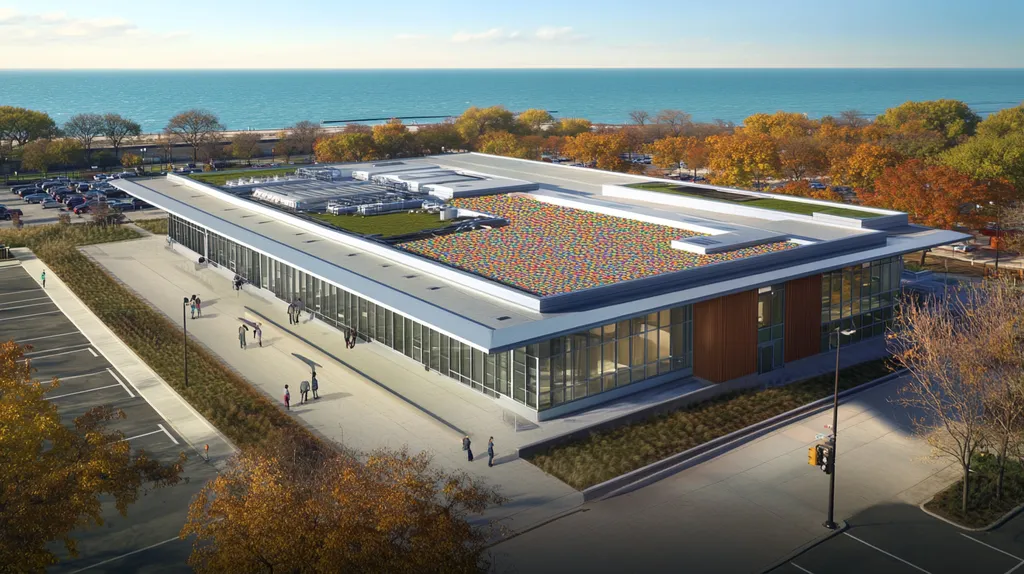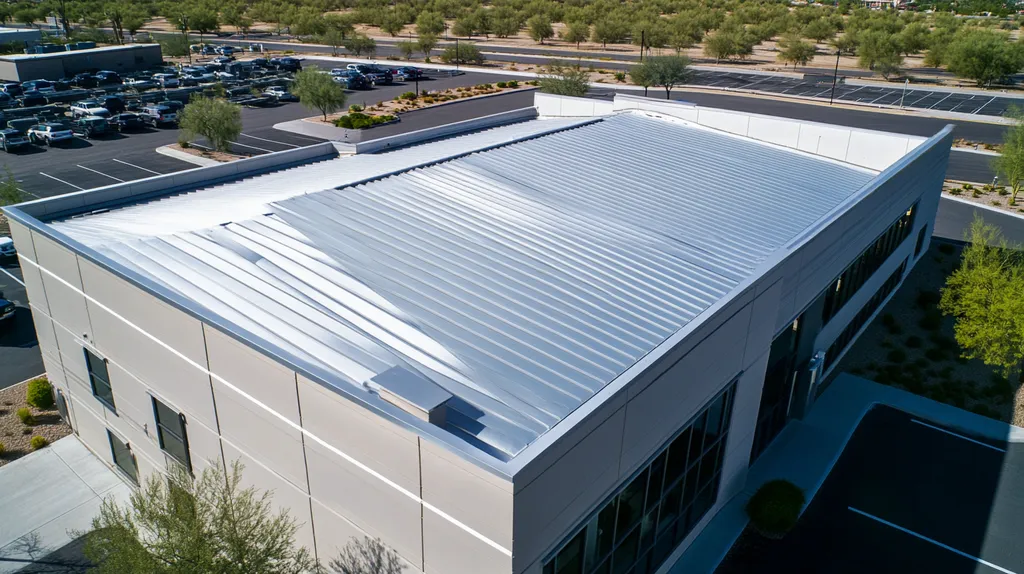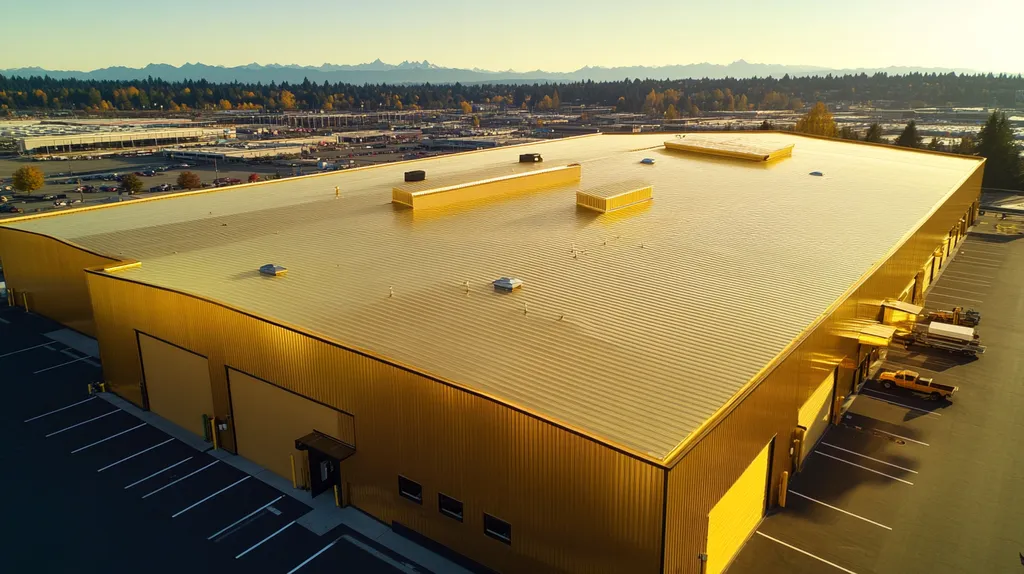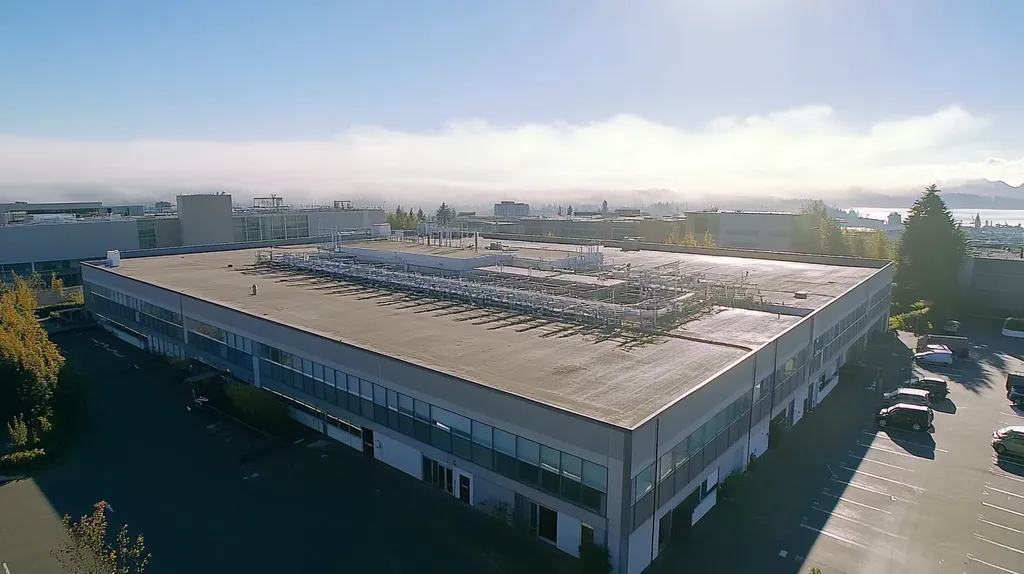Commercial property owners face a critical challenge: financing essential roof repairs and replacements that often exceed $250,000 for a typical 20,000-square-foot installation. Industry data shows that delaying these projects due to funding constraints leads to 30% higher costs when emergency repairs become inevitable.
While traditional loans remain common, innovative financing solutions like equipment leasing, performance contracts, and government incentive programs now offer viable alternatives. Understanding these options can mean the difference between proactive maintenance and costly reactive repairs.
This comprehensive guide examines performance factors, financial considerations, compliance requirements, risk management strategies, operational procedures, and long-term planning to help property professionals make informed roofing investment decisions.
SECTION 1: PERFORMANCE FACTORS
The selection of a commercial roof is more than a stylistic choice; it represents a significant financial commitment that influences ongoing operational expenses. Research indicates that neglecting roof maintenance can inflate energy bills by as much as 25%, alongside incurring hefty repair costs. Grasping the performance aspects of a roofing system is crucial for property professionals aiming to make strategic financing choices that align with their facility’s requirements.
Structural Integrity Assessment
Conducting a thorough structural integrity assessment is a crucial step before installing a new commercial roof. Property owners need to examine the existing structure to confirm it can support the new roofing materials. This assessment should take into account the building’s age, any past repairs, and possible load-bearing challenges.
For example, if a flat roof needs stronger materials due to previous design limitations, overlooking this requirement can lead to costly leaks and damage. Making this investment now could prevent thousands in unforeseen repair expenses later.
Additionally, structural testing may uncover underlying problems that might otherwise go unnoticed. Addressing these vulnerabilities at the outset contributes to a more robust roof, reducing the likelihood of structural failure during extreme weather events.
Key Action Items
Energy Efficiency Considerations
Energy efficiency is integral to the performance of a commercial roof. It’s vital for property professionals to select roofing materials that reflect heat instead of absorbing it. Data suggests that an energy-efficient roof can lead to cooling savings of up to 20% annually.
For instance, the application of reflective coatings and the use of lighter roofing materials can significantly lower energy expenditures. Beyond just reducing costs, these energy-efficient systems could qualify property owners for tax credits or rebates, providing essential budget relief.
Moreover, investing in energy-efficient roofs often results in longer warranties and increased durability. Opting for higher-quality materials can extend the lifespan of the roof, minimizing the need for frequent replacements and repairs, making the case for financing these options even stronger.
Key Action Items
Weather Resistance Evaluation
Assessing weather resistance is vital when selecting a commercial roofing system. Properties situated in regions vulnerable to severe weather must have roofs capable of enduring diverse climate conditions, including strong winds, heavy rainfall, and extreme temperature ranges.
For instance, roofs designed to withstand high winds can help mitigate storm-related damage, thereby avoiding costly repairs. A robust roofing system not only safeguards the building’s interior but also reduces the risk of mold and moisture associated health problems for tenants.
Additionally, a detailed evaluation of weather resistance allows property managers to anticipate and plan for future maintenance needs. Investing in roofs that resist environmental stressors often results in fewer emergency repairs and can even lower insurance costs over time.
Key Action Items
SECTION 2: FINANCIAL CONSIDERATIONS
In the current business climate, overlooking roofing needs can lead to costly operational disruptions and financial headaches. Commercial roofs are essential assets, yet budget constraints often prevent property owners from executing necessary repairs or upgrades on time. Crafting a well-thought-out financial strategy is vital for managing roofing effectively. This section delves into budget strategies, cost estimation methods, and compares various financing options available to property professionals.
Budget Allocation Strategies
Implementing effective budgeting is crucial for managing commercial roofing costs. Property managers should earmark a specific percentage of their annual budget—typically 1-2% of the property’s value—for roofing maintenance and upgrades. This proactive approach helps ensure a safety net for essential repairs.
It’s important to prioritize expenditures based on the roof’s condition and anticipated lifespan. For instance, planning for a roof replacement when nearing its life cycle can be more financially sound than opting for costly repairs that may only provide temporary relief.
Regular roof inspections are key in identifying potential problems early, allowing property managers to budget for necessary repairs in a timely manner. Additionally, establishing a contingency fund can provide extra peace of mind, protecting against financial strains from unexpected roofing issues.
Key Action Items
Cost Estimation Techniques
Accurate cost estimation is vital in avoiding budget overruns during roofing projects. Utilizing standard industry calculations can guide property managers in creating reliable estimates. To establish a realistic budget, experts recommend obtaining multiple quotes from qualified contractors.
Understanding the complete scope of each project—including materials, labor, and disposal fees—will lead to more precise budgeting. Commonly, cost is measured per square foot, providing a foundational figure around which financial planning can revolve.
It’s also worthwhile to consider the long-term savings from specific roofing solutions, such as energy-efficient options, which might have higher initial costs but could lead to reduced operational expenses over time.
Key Action Items
Financing Option Comparison
Understanding financing options is crucial for budget planning in commercial roofing projects. Traditional bank loans often come with structured repayment terms, potentially requiring collateral. This may work well for property managers who prefer predictable payment arrangements.
Alternatively, financing directly through roofing contractors can offer flexibility, enabling immediate project start without hefty upfront costs. This can help maintain cash flow while resolving urgent roofing issues.
Leasing is another viable option, allowing property managers to pay for roofing over time without owning the system until the lease concludes. This approach can particularly benefit businesses with variable income. Moreover, don’t overlook government grants and tax incentives for energy efficiency; these can greatly reduce overall installation costs.
Key Action Items
SECTION 3: COMPLIANCE REQUIREMENTS
Compliance with regulations is paramount for property owners planning a new commercial roof. Ignoring these requirements can result in heavy fines, project delays, and even legal issues. Shockingly, about 75% of claims against roofing contractors stem from compliance-related problems, highlighting the need for vigilance. This section outlines the essential considerations regarding building code regulations, environmental compliance standards, and the importance of reviewing insurance policies.
Building Code Regulations
It’s essential to follow local building codes during roofing projects, as each municipality has regulations concerning materials, structural integrity, and safety features. For example, some states require roofs to support specific wind loads or snow accumulation.
Failing to comply with these rules can lead to expensive rework or fines, impacting both safety and your roof’s longevity. Engaging knowledgeable roofing professionals ensures adherence to local regulations.
With building codes frequently updating, ongoing education is crucial for contractors and facility managers. Proactively addressing compliance can prevent financial surprises and keep your roofing project on track. A thorough understanding of these codes can save significant costs in future repairs.
Key Action Items
Environmental Compliance Standards
The increasing focus on sustainability means that property owners must adhere to rigorous environmental standards in their roofing projects. Regulations concerning energy efficiency and materials directly affect decisions related to roofing materials.
Choosing eco-friendly options can open doors to tax incentives and rebates, providing financial relief. However, understanding and navigating these requirements can be complex, so working with experts in green building standards is recommended.
Non-compliance may damage a property’s reputation and discourage future tenants. Properties that practice environmental sustainability are more attractive to investors and tenants alike, hence staying updated on evolving regulations can ensure compliance and enhance market appeal.
Key Action Items
Insurance Policy Review
Before beginning any roofing project, a detailed review of insurance policies is essential. Property owners must confirm that their coverage includes specifics related to roofing repairs or replacements to avoid significant financial exposure.
Many insurance policies may not cover certain roofing materials or specialized installations. Understanding your coverage terms and limitations can empower property managers to make informed decisions while also ensuring effective budgeting.
Engaging an insurance professional can simplify this complex task. Conducting regular policy reviews helps adapt to changes in risks or regulations, ensuring roofing investments remain protected and potentially lowering premium rates.
Key Action Items
SECTION 4: RISK MANAGEMENT
Effective risk management is essential in the commercial roofing sector. When a roof fails, it can lead to significant financial losses and liability problems for property owners. Alarmingly, research shows that poor maintenance and lack of planning contribute to about 30% of all commercial roof replacements. By understanding risk assessment methodologies, liability reduction strategies, and emergency response planning, property managers can not only protect their investments but also reduce unnecessary costs.
Risk Assessment Methodologies
A comprehensive risk assessment is the foundation of effective roofing management. Routine inspections are critical for identifying potential problems early. For example, advanced drone technology can uncover wear-and-tear that is otherwise invisible during manual checks.
In addition, property managers should integrate software to monitor roofing conditions over time. This approach enables data-driven decisions regarding repairs and potential replacements. Consistent assessments extend the roof’s lifespan and help refine financing plans.
Risk considerations should also account for environmental factors such as local wildlife, climate, and adjacent construction that could impact roof longevity. By assessing these risks, property managers can tailor their mitigation strategies accordingly.
Key Action Items
Liability Reduction Strategies
Minimizing liability starts with securing comprehensive insurance tailored for roofing needs. Standard property insurance may not cover all incidents related to roofing failures or damages. Property managers should engage with insurance professionals to ensure sufficient coverage for maintenance and replacements.
Moreover, establishing routine maintenance programs is vital for limiting risks. Regular seasonal inspections can catch minor issues before they escalate into significant problems. Keeping a detailed log of inspections and repairs can also demonstrate due diligence in case of any claims.
Clear communication with contractors regarding safety standards is equally crucial. Well-defined contracts that outline roles and warranties can protect property owners from unexpected liabilities. This clarity fosters a mutual understanding of responsibilities regarding risk management.
Key Action Items
Emergency Response Planning
Formulating an emergency response plan is a key aspect of effective risk management. Property managers must prepare contingency plans for roofing emergencies like leaks or storm damage. This preparedness ensures a swift response and minimizes overall damage and costs.
Training staff in emergency procedures is also vital. Establishing a clear communication chain can facilitate prompt notifications to contractors and emergency services in the event of a roof failure. Conducting regular drills ensures that employees are ready to react quickly.
Creating strong partnerships with experienced roofing contractors equips property managers with immediate support during crises. This collaboration can accelerate repairs and reduce downtime, thereby saving costs in urgent situations.
Key Action Items
SECTION 5: OPERATIONAL PROCEDURES
Proper operational procedures are critical for navigating the complexities of commercial roofing projects. When a project is poorly managed, the risks include inflated costs, delays, and potential safety concerns. Property owners must prioritize careful planning, execution, and oversight to safeguard their investments. This section will cover essential operational procedures, such as project planning, contractor selection, and quality control measures, to ensure successful roofing outcomes.
Project Planning and Scheduling
Effective project planning serves as the foundation for any roofing project. It begins by evaluating the specific needs of the property and selecting the appropriate roofing system. Property owners should create a detailed timetable outlining key milestones, including start and completion dates, to help keep the project on schedule.
Incorporating a contingency plan is also crucial. Weather-related delays and material shortages can occur, so having backup solutions ready minimizes disruptions. Establishing clear communication channels with all stakeholders ensures everyone understands their roles, fostering accountability throughout the project.
Allowing adequate time for each phase is essential. Tight timelines can lead to mistakes and inferior work quality, which can incur higher costs for repairs and litigation down the line. Adhering to a well-structured schedule not only aids in meeting regulations but also improves overall project efficiency.
Key Action Items
Contractor Selection Criteria
Choosing the right contractor is crucial for a successful roofing project. Property owners should establish clear criteria for assessing potential contractors before deciding. This includes verifying licenses, insurance, and their reputation within the community.
Requesting references and examining previous projects can provide valuable insights into a contractor’s reliability and workmanship. Contractors with a proven track record not only bring expertise but also reduce risks associated with project execution.
Evaluating the contractor’s financial stability is also vital. A financially sound contractor is less likely to experience issues that could delay the project or lead to unexpected costs. Conducting interviews is essential to assess their commitment to safety and quality control practices.
Key Action Items
Quality Control Measures
Implementing strong quality control measures is essential for ensuring a durable roof. Quality control begins with selecting high-grade materials that meet industry standards, as this directly influences the roof’s longevity. Property owners should confirm that all materials used adhere to manufacturer specifications.
Conducting regular inspections during the installation process is another key measure. Appointing a project manager to oversee progress ensures issues are identified early, preventing costly rework in the future. Consistent assessments allow for adjustments, ensuring compliance with project specifications.
Additionally, third-party inspections can provide extra accountability. Independent reviews can catch oversights that internal teams might miss. Engaging external experts often enhances workmanship quality and protects property owner investments.
Key Action Items
SECTION 5: OPERATIONAL PROCEDURES
Proper operational procedures are essential for managing the intricacies of commercial roofing projects. Inadequate management can lead to inflated costs, project delays, and safety hazards. For property owners, failing to prioritize effective planning, execution, and oversight poses significant risks to their investments. This section provides key operational procedures related to project planning, contractor selection, and quality control to ensure successful roofing outcomes.
Project Planning and Scheduling
Thorough project planning is the cornerstone of any effective roofing initiative. It starts with assessing the property’s specific needs and determining the most suitable roofing system. Owners should establish a detailed timeline that outlines key milestones, such as start and completion dates, to keep the project on track.
Additionally, incorporating a contingency plan is vital. Weather-related delays and material shortages are common, so having backup solutions ready can minimize disruptions. Clear communication channels with all stakeholders ensure everyone understands timelines and responsibilities, fostering accountability throughout the project.
Allowing enough time for each project phase is equally important. Rushed timelines can lead to mistakes and inferior work quality, ultimately increasing costs for repairs later. Utilizing project management software can streamline planning and facilitate real-time updates, enhancing overall efficiency.
Key Action Items
Contractor Selection Criteria
Choosing the right contractor is critical for ensuring project success. Property owners should develop clear criteria for assessing potential contractors prior to making a selection. This includes verifying licenses, insurance, and a solid local reputation.
Requesting references and reviewing past projects offer valuable insights into a contractor’s reliability and work quality. Contractors with demonstrated success not only bring expertise but also lessen the risks associated with project execution.
Financial stability is another key factor. Contractors with sound financial backgrounds are less likely to encounter issues that could delay the project or escalate costs. Interactions and interviews with prospective contractors should focus on their commitment to safety and quality control, which is crucial for safeguarding the project.
Key Action Items
Quality Control Measures
Implementing effective quality control measures is crucial for achieving a durable roofing solution. It begins with selecting high-quality materials that meet industry standards, which directly affects the roof’s longevity. Property owners must ensure all materials adhere to manufacturer specifications.
Regular inspections during the installation process are vital. Designating a project manager to supervise work helps identify issues early, preventing expensive rework later. Frequent assessments allow for necessary adjustments, ensuring compliance with project specifications.
Moreover, engaging third-party inspectors can enhance accountability by providing independent evaluations that may catch mistakes overlooked by internal teams. Establishing a clear process for addressing deficiencies ensures that contractors rectify any quality issues promptly before the project concludes.
Key Action Items
The Bottom Line
Commercial property owners face a critical decision point: secure optimal financing for roofing projects now or risk 30% higher costs from emergency repairs later.
While traditional loans remain common, innovative options like equipment leasing and performance contracts now give property managers more flexibility in funding essential roof work.
Government incentives and tax benefits for energy-efficient roofing systems can offset 15-25% of project costs when properly leveraged.
The key is taking action before minor issues escalate into major expenses – data shows that every dollar spent on preventive maintenance saves $4 in future repairs.
By exploring available financing solutions and implementing proper planning strategies, property professionals can protect their assets while maintaining healthy cash flow.
FREQUENTLY ASKED QUESTIONS
Q. What factors should I consider for a commercial roof’s performance?
A. The performance of a commercial roof depends on its structural integrity, energy efficiency, and weather resistance. Performing regular assessments can identify weaknesses and help you make informed maintenance decisions.
Q. How can I effectively budget for industrial roof repairs?
A. To effectively budget for repairs, allocate 1-2% of your property’s value annually for roofing needs. Schedule regular inspections to assess the roof’s condition and ensure timely repairs to prevent larger costs later.
Q. What are the essential compliance requirements for a commercial roof?
A. Compliance involves adhering to local building codes and environmental standards. Ensure that roofing projects meet specific material and structural requirements to avoid fines and ensure safety.
Q. How can I assess risks associated with a commercial roof?
A. Conduct regular inspections to identify potential risks and use technology like drones for detailed assessments. Integrate software for monitoring the roof’s condition over time to make data-driven decisions.
Q. What should I include in my operational procedures for roofing projects?
A. Your operational procedures should cover project planning, contractor selection, and quality control measures to ensure that your roofing projects stay within budget, on time, and up to standards.
Q. How can I evaluate financing options for a new commercial roof?
A. Consider traditional loans, contractor financing, or leasing options. Evaluate their terms, costs, and potential impacts on cash flow. Research available government grants or tax incentives that can help reduce your overall expenses.
Q. What should I do if my commercial roof is damaged during a storm?
A. Immediately assess the damage and document it thoroughly. Communicate with your insurance provider and contact a reliable roofing contractor for repairs. Establish a clear emergency plan to handle such situations more effectively in the future.

